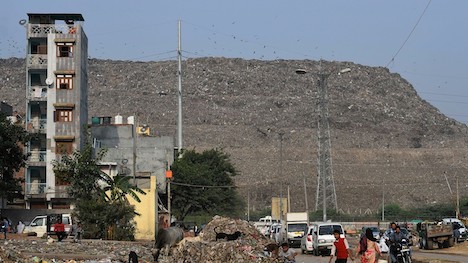India’s trash mountain will be 'bigger than the Taj Mahal by 2020'
 Print This Print This
By Staff Writers | RT
RT.com
Saturday, Jun 22, 2019
 |
| © AFP / Prakash Singh |
India’s tallest trash mountain, dubbed the ‘Mount Everest of trash,’ is now so high it requires warning lights for aircraft overhead and will soon be higher than the famed Taj Mahal.
The towering Ghazipur landfill is almost the size of 40 football fields, stretching more than 65 metres (213 feet) high, and rises by nearly 10 meters each year, putting it on course to grow taller than the Taj Mahal (73 meters) by 2020, reports AFP.
Last year, India’s Supreme Court warned that red warning lights would soon need to be put on the dump to alert passing jets. It seems that time has now come, solidifying the garbage dump as the international symbol for the planet’s pollution legacy.
The Ghazipur landfill first opened outside New Delhi in 1984 and was penned to close when it reached its capacity in 2002. However, hundreds of trucks still arrive with about 2,000 tonnes of garbage each day.
Dumping was temporarily banned in 2018 after heavy floods caused part of the mountain to collapse, killing two people. It was reopened after a matter of days, though, when authorities couldn’t find an alternative.
Methane gas fires are a common occurrence at the dump, while leachante, a black toxic liquid, oozes from the mountain into a local canal. Many locals complain of breathing difficulties and stomach problems from inhaling the polluted air.
Environmental advocacy groups have been calling for the dump’s closure, saying it’s unsafe for anyone to live within five kilometers (three miles) as it poses a significant health risk, including cancer.
While India actually has a relatively low rate of plastic consumption per capita at 11kg per year, in comparison to Western countries who consume about 10 times that, recycling and garbage disposal remains their biggest problem. To battle the issue, India banned imports of plastic waste earlier this year, and pledged to completely phase out single-use plastics by 2022.
Source URL
|
 Print This Print This

|

